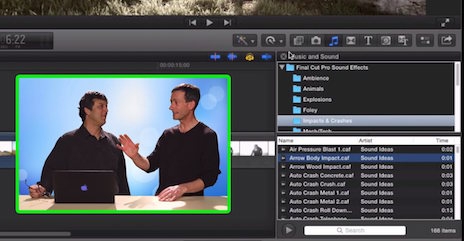This post is prompted by the following questions and comments from a reader:
Was AE used for Davey Jones in Pirates 2? Is it capable of those kinds of effects or was that another program altogether? I don’t expect to do anything that advanced in my movies yet but I love learning new things.
I’ll extract the real question here, rather bluntly, and then address it (hopefully without falling into the usual traps inherent in comparing software, operating systems, religion, sexuality and party politics): Is After Effects a real high-end tool or does its mass appeal make it more limited?
The short answer is: you can do pretty much anything you can think of (2D compositing-wise, at least), in After Effects.
That’s it. Seriously.
Okay then, has it been used at the pinnacle of effects work? Yes. Want proof? Look at The Day After Tomorrow, which I happen to know was composited in just about every package available – not just After Effects but Flame/Inferno, shake, Nuke, and probably more. Can you tell which shots were done in After Effects? Of course not. But now it gets complicated. Is After Effects the software of choice at most high-end visual effects houses?
Clearly not.
Although the list of features on which After Effects has been used is long and prestigious, numbering well into the hundreds, among high-end visual effects houses, The Orphanage (and preceding them, ILM) have been prominent among a very few to use After Effects for the biggest vfx jobs. Why? Is After Effects not up to the demands? Let me try to avoid the religion/politics part be as simple and concise as possible.
There are four basic points on which compositing software (and, perhaps, all software) is evaluated:
A) Features
B) Performance
C) Workflow
D) Price
Which of these is 80-90% responsible for major vfx companies choosing anything but After Effects? If you said C, we agree. After Effects does not fall short on features, nor is its performance truly inferior, compared with other desktop sotware. It’s price used to be cheap but would now be considered middle-of-the road with shake having reached the bargain bin.
Yes, with every new release of After Effects, people find some feature to pick on that other software has and it lacks, but if you pay attention, that’s true of all of its competitors as well. The After Effects team has consistently responded to the needs of the visual effects community, and the complaints of what’s missing (individual curves for x, y and z axes! More iterations in the motion blur!) are not true deal breakers.
And yes, work in After Effects can be slow on a big shot – but I can tell you from working on 2K plates in Shake, very similar speed issues exist there unless you manage the shot properly, something I focus on quite a bit in the After Effects Studio Techniques books.
The real reason After Effects isn’t considered for more feature films clearly has to do 80-90% with workflow.
But here’s the funny paradox: of all of the major desktop compositing software packages available, only After Effects has been used both for the highest-end visual effects work and the highest-end motion graphics. And because the needs of those communities, while closely related, are unique, serving both markets actually makes the After Effects workflow more complicated for visual effects work. Certain operations require far more steps in After Effects and involve pre-composing, an operation foreign to the all of the other node-based competition.
Therefore you could make the case that After Effects is its triumph – it is more versatile than the competition. So what makes the difference?
The strength, and therefore the Achilles heel of After Effects is the Timeline. It is the heart of the application (or as I call it in my book, the “killer app”), the place where all of the work gets done, and it allows for complex timing and spatial animation of elements. Among all major compositing packages, this workflow is unique to After Effects.
And in some cases, the Timeline becomes a liability instead of the fantastic feature that it often is.
Why, you might ask, if I can acknowledge that After Effects isn’t the software of choice at most feature effects studios, do I persist in writing books about doing feature-quality visual effects work in After Effects? Two reasons come instantly to mind:
1) Today and for the forseeable future, more shots will get done in After Effects than in all of the others combined.
2) I can comfortably argue that After Effects is more powerful than the competition, because of the breadth and depth of work you can do with it.
Number one is a no-brainer. There are way, way more copies of After Effects out there than Shake, even now that it costs half as much. Even if, out of the dozen or two highest-end vfx shops, only a handful use After Effects, when you add the full range of artists creating visual effects for everything from television to youtube, After Effects moves into the dominant position. And with good reason – you can deliver the highest quality results with it. In the previous post I acknowledged what specifically about the workflow hangs up film compositors about After Effects, but there have still been an awful lot of film shots done in it, and will continue to be.
Number two is also a no-brainer, if you consider this: try to create the highest-end motion graphics and the highest-end visual effects in a single compositing package. The only other software that is even a candidate to do this is probably Combustion, and because I don’t use it, I can’t make a meaningful comparison – I just know that it’s the only one that even has a comparable feature-set, because it offers both nodes and a timeline. In my books I refer to the After Effects timeline as its “killer app” – ask a shake artist to create a shot that involves lots of intricate timing, the choreography of numerous elements and type, and then listen for the howls of pain.
And maybe that’s the point – most feature film effects don’t involve the type of animation and timing artistry that requires the timeline, and so feature film artists end up paying the price of pre-composing and nesting compositions without typically getting the benefit of this fantastic feature.
So, while I can put on my pundit hat and admit that After Effects CS3 doesn’t add anything that would win over the feature effects houses – except maybe the forward-looking Color Management features and the amazing Puppet toolset, along with a few other features I’ll mention in my next post – I know that I, and many other artists, will be creating uncompromising effects and graphics in After Effects for years to come. As for Nuke and Motion – well, they make things interesting. We’ll see if the former can become user-friendly enough, and the latter deep enough to sway After Effects die-hards like me.
An in-depth comparison of After Effects and Shake seems a little pointless, given that Apple seems to have dropped Shake entirely – and I do mean, entirely. Last June we found out that the product known as “shake” (not officially capitalized – I’m just doing that for clarity) was officially End-Of-Life, that 4.1 would be the last version, and that it was even possible to license the source code for $50,000 – remember that fire sale?
With NAB 2007, the other shoe seems to have dropped. There was no mention of a Shake successor whatsoever, but heavy promotion of Motion 3 (which, while looking fast and cool, has until now – to me, at least – been more about eye candy than the rigors of creating a realistic looking shot). A visit to the Foundry booth revealed a few new faces – veterans of Nothing Real and the Apple Shake team. Ron Brinkman announced he was leaving Apple. Other rumors held that key Shake developers still at Apple, those essential to any succeeding version, had been pulled over to the Aperture team.
I remarked on a roundtable panel at NAB that the current situation for effects compositing software is reminiscent of where 3D software was at in the late 1990’s – remarkably up-for-grabs, with no clear current leader. All signs currently seem to point toward Nuke moving into the pole position, but how quickly and universally this happens depends on the timing, pricing and features of version 5, the first one which will show where Foundry wants to take it. If the UI is massaged to be nicer looking and friendlier, the license costs fall more in line with the competition, and version 5 appears before the end of the year and proves as stable and fast as its predecessors, watch out.
And where does this leave After Effects? This is a bit of a half-full, half-empty type of question. Motion is trying to provide all of the motion graphics features of After Effects but with a simpler, more real-time experience. Nuke is focused on providing all of the next-generation visual effects features, such as camera projection and full support for EXR files, which are unavailable in an application like Motion and available but less-than-straightforward to use in After Effects.
All of which brings us back to the topic of “Mythbusting” – where is After Effects at a true disadvantage relative to the competition? I could name a long list of items, but one could do that for any piece of software. Fundamentally, there are two longstanding disadvantages for After Effects which continue to loom large:
1) UI responsiveness
2) Pre-composing
Responsiveness: Nuke is a super-responsive and highly interruptable application, even compared with Shake. With After Effects, one can end up waiting several seconds (or longer) just for a frame to stop redrawing (even if one enables caps lock or the option/alt key explicitly for this purpose). Whether or not this actually leads a shot (or a whole show) to take longer to complete in After Effects, the point is that the application feels so much slower is many cases that artists at all levels – beginners and experience pros alike – become biased against its overall performance. In 2007 it should never be difficult to adjust a simple slider control because the machine is busy doing something else.
Pre-composing has long been the bane of After Effects; it seems to be the price we pay to work in the Timeline. With each new version, features are added to ease the pain; CS3 offers a prominent new button in the Timeline which allows you to see and select other compositions in which the current composition is used. Nevertheless, pre-composing is a pain because it adds steps and obscures vital data.
Oddly enough, Motion 3 (on the motion graphics side) and Nuke (on the effects side) both aim squarely at these weaknesses in After Effects. I have only seen the Motion demo – it isn’t even publicly available at this writing – but its features seem less obscure and its image processing faster (thanks to heavy use of the GPU) than After Effects. Whether that comes at the price of sophistication and control remains to be seen, but I doubt that Motion would ever be used to complete an effects shot on a feature. Nuke, meanwhile, is also astoundingly responsive with huge shots, and it has the familiar advantage of any node-based system : no pre-composing.
We’ll know more later this year about how all of this shakes out. Meanwhile, it seems pretty clear that in the long run, shake’s out.
Why, you might ask, if I can acknowledge that After Effects isn’t the software of choice at most feature effects studios, do I persist in writing books about doing feature-quality visual effects work in After Effects? Two reasons come instantly to mind:
1) Today and for the forseeable future, more shots will get done in After Effects than in all of the others combined.
2) I can comfortably argue that After Effects is more powerful than the competition, because of the breadth and depth of work you can do with it.
Number one is a no-brainer. There are way, way more copies of After Effects out there than Shake, even now that it costs half as much. Even if, out of the dozen or two highest-end vfx shops, only a handful use After Effects, when you add the full range of artists creating visual effects for everything from television to youtube, After Effects moves into the dominant position. And with good reason – you can deliver the highest quality results with it. In the previous post I acknowledged what specifically about the workflow hangs up film compositors about After Effects, but there have still been an awful lot of film shots done in it, and will continue to be.
Number two is also a no-brainer, if you consider this: try to create the highest-end motion graphics and the highest-end visual effects in a single compositing package. The only other software that is even a candidate to do this is probably Combustion, and because I don’t use it, I can’t make a meaningful comparison – I just know that it’s the only one that even has a comparable feature-set, because it offers both nodes and a timeline. In my books I refer to the After Effects timeline as its “killer app” – ask a shake artist to create a shot that involves lots of intricate timing, the choreography of numerous elements and type, and then listen for the howls of pain.
And maybe that’s the point – most feature film effects don’t involve the type of animation and timing artistry that requires the timeline, and so feature film artists end up paying the price of pre-composing and nesting compositions without typically getting the benefit of this fantastic feature.
So, while I can put on my pundit hat and admit that After Effects CS3 doesn’t add anything that would win over the feature effects houses – except maybe the forward-looking Color Management features and the amazing Puppet toolset, along with a few other features I’ll mention in my next post – I know that I, and many other artists, will be creating uncompromising effects and graphics in After Effects for years to come. As for Nuke and Motion – well, they make things interesting. We’ll see if the former can become user-friendly enough, and the latter deep enough to sway After Effects die-hards like me.

Filmtools
Filmmakers go-to destination for pre-production, production & post production equipment!
Shop Now













